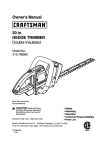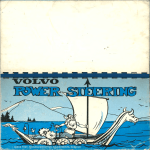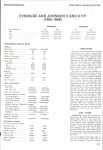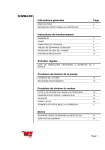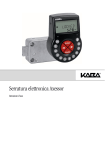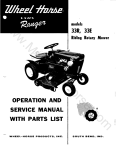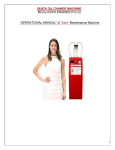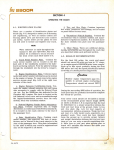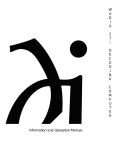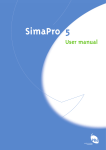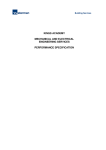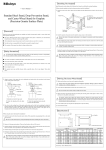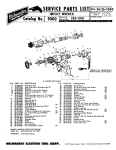Download "service manual"
Transcript
THE SERIES TRANSAXLE GEARBOX UNITS These units are designed for use with 300 to 450 cu. inch competition engines, and are manufactured as two, four and five speed models. The present manual deals with the four speed unit (LG 500) and the five-speed unit (LG 600). Only one final drive ratio is used (3.3 : 1). Since the drive is indirect at all times, any change in ratio can be made through the gearbox. The drive is taken from the clutch shaft to the hypoid final drive via straight cut gears. Gear change is effected by non-synchronised face dogs. Ratios can be changed without removing the unit from the chassis, and all requirements can be met from OUT extensive range of gears. All ratios except bottom are inter-changeable, and may be arranged in any order. The differential and crown wheel assembly is mounted on two taper roller bearings, located in the side plates and adjustable to correct load by shims. Output shafts are also mounted in the side plates, and lip oil seals are fitted. The pinion is supported by a double angular contact bearing clamped to the case directly behind the gears. This bearing accepts the major radial and thrust loads, while a roller bearing supports the tail. Thus pinion mesh can never be affected by case expansion. The gears run directly on caged needle roller bearings, and each gear and bearing revolves as an assembly. Heat treated nickle-chrome steel is used for all gears and shafts. Selector forks are cast in aluminium bronze, and casings in magnesium alloy. The differential is of Limited Slip design, and two types are manufactured. The unit normally the cam and type. The other is supplied type, operated by flat clutch the plates. Both units are illustrated. The gearbox unit is lubricated by oil splash, and the final drive by pump. The pump is located in the main case, and is fed via a filter which can be withdrawn from the of the case. The oil is piped out of the main case on the hand side and returns via external piping, thus providing for the fitting of an oil cooler. The latter is strongly recommended to ensure that oil temperature does not exceed its maximum of 110°C (250°F). The gear-change rod is mounted high on the right-hand side of the unit to facilitate the installation of the gear line linkage. The clutch operated by steel fork and push-rod accepted as the simplest and most reliable system, especially with monocoque chassis. The push-rod is actuated from a slave cylinder mounted on the side of the main case. The general configuration of the LG Series provides the maximum utilisation of power allied to minimum weight for the power required to be transmitted. 3 6, 7 . . . . . . . ... 7 . . . . . . . . . . . . . . . Hubs 16 6 6 12 . . . . . . . . . . . . . . . Gearbox Unit . . . . . . . . . . . . . . . . . . Gear Ratios, changing Gear Ratios, standard and special ... Filter End Case 6 . . . . . . . . . . . . 9 14 12, 14 6 9 12 ... ... ... . . 9, 14 6 6 9 14 PAGE ... ... ... ... . . . . ... ... .. ... ... Pinion, setting up . Differential Unit, removal . . . Differential Unit, dismantling Clutch Rings . Clutch Shaft . Crown Wheel . Crown Wheel Backlash, adjusting ... ... Bearing Carrier (Main) ... Bearing Carrier (Clutch shaft) B e a r i n g s and pinion, front and pinion, tail . . . Index . . . . . . and type . . . . . . . . . .... 9, Technical specification ... ... Selector Finger . . . . . . Selector Forks, removal Selector Forks, setting up . . . . . . . . . . . . . . . Selector Heads Selector Rods . . . . . . . . . . Setting up Crown Wheel Pinion ... . . . . . . . Selector Forks . . . . . . . . . Side Plates, removal . . . . . . Side Plates, dismantling Reverse Idler Gear . . . . . . . . . Pinion . . . ... Plungers ... Pre-load, adjusting. Oil, Oil Pump Oil Filter Main Case and Diff. 9 2 12 14 7 6, 7 6, 6 6, 7 9 14 6 14 4 10, 12 10, 12 9 PAGE General notes on maintenance and overhaul Only genuine spares should be used as replacements. These are manufactured in our own workshops to the fine tolerances necessary, and rigorously inspected and tested. New nuts and gaskets should always be used on reassembly. When warming the outside of the case, keep the lamp moving. Do not overheat. Test with a spot of moisture, which will bounce off when the case is hot enough. When refilling with oil, put half the quantity into each one oil sump. filler hole. Never put all the oil NO. ___ Tail Sleeve Oil Seal Starter Sleeve Hub First Second Reverse Steel Ball Selector Rod Spring Selector Rod Screw Plungers Stud Stud Washer 6” Blanking Plug Selector Finger Housing PI unger Spring Plug Bush Alloy Spacer Screw .. End Cover END Cover Rear Start Oil Seal End Cover Cover Starter Spline Allen Cap Screws Nyloc Nut UNF Filler Cap Nyloc Nuts Stud Bearing Corrier DESCRIPTION T 2027 2028 203 2021 LG LG LG LG LG LG 2261 227 228 2291 2292 H C FT 2032 FT 2035 FT 2036 LG 20310 FT 20311 LG 204 LG 204R LG 2041 LG4 2042 LG4 2043 LG4 2046 LG 2044 LG 2045 LG 20416 LG 20417 LGS 226 FT FT F FT FT 2013 LG 2025 LG 5 202 PART NUMBER 1 1 1 4 1 1 1 4 4 1 1 1 1 43 2 2 1 6 43 8 1 2 1 43 2 1 43 8 1 4 Not Illustrated Not I I lustrated Not Illustrated Not Illustrated Nat Illustrated Not Illustrated Not Not Illustrated Not lllustmted 5 Speed 4 Speed 5 Speed REMARKS NO. Spares List A Loyshaft Gears Other Ratios Adjusting Spacer Selector Finger Gasket End Cover Gasket Selector Finger Housing Pinion Gears All Ratios Layshoft Gear Selector Fork - LG LG LG 252 260 261 1 3 1 LG5 251 - 1 1 3 1 1 1 2 1 1 !TY LG5 250 Selector Fork Selector Fork LG5 249 2462 247 2341 LG 2342 LG 2343 LG 2345 LG 2346 LG5 246 LG5 234 Rs LG4 234 Rs FT LG Reverse Rear Front 231 2295 230 2301 2302 LG 232’ LG5 234 LG LG LG LG PART NUMBER Nut Selector Selector Rod Thrust Washer Swcer Lovshaft Selector Rod First Bearing Circlip Clutch Ring 5 Speed Thrust Washer Pinion Nut Washer Split Pin Reverse First Sliding Gear DESCRIPTION 3 4 1 1 1 J-. -l-- 3 1 1 1 1 1 1 2 2 4 5 Speed -4 Speed 5 Speed 4 Speed Mode on Assemble 5 Speed 5 Speed 4 Speed 5 Speed 4 Speed Rear Start 5 Speed Rear Start 4 Speed 5 Speed 4 Speed REMARKS GEARBOX UNIT, SPARES LIST AND DIAGRAM 5 1 7 I 15 Remove the split pins from the castellated nuts. pinion and be correctly paired UNC UNF nuts and washers, cap screw. RATIOS When changing a gear ratio, take off the slackened from the bearing carrier. nut and remove the one from the Gears are exchanged in pairs shaft and one from the pinion shaft. Each gear is CHANGING Replace in reverse order to above. 2. Using a plastic mallet, tap the bearing carrier with and remove it from the main case, lay-shaft assembly and gear train. Support the gears, hubs and clutch rings with the hand, as they come off the pinion. 1. Remove the and the BEARING CARRIER 6 7. Take off the Selector Finger Housing by undoing cap screw and two UNF nuts. Then the remove the two remaining forks. (On the 4-speed gearbox, to remove selector finger it is necessary to undo reverse selector fork and push rod down until head is clear of the others). 6. Remove or by sliding it into the selector head, and pushing the rod the head is clear of the others. 5. Remove bung, spring and plunger (13, 14, 15) from the selector finger housing. 4. Knock back the tab and unscrew the nut from the fork, (44). Remove the fork. 3. If forks are not to be stripped, check that nuts are tight and properly tabbed. To continue 2. Examine forks for heavy or uneven wear, and test for excessive play between forks and clutch rings. Now withdraw the two outside selector rods, to disengage the gears. 5. inspect for wear and cracks, giving particular attention to the clutch rings. 1 . Remove hubs, clutch rings and gears. Wash and STRIPPING THE GEAR TRAIN It is essential that gears according to these numbers. etched with two numbers. The first is the number of its own teeth. The second is the number of teeth on its mating gear. 4. Remove the pinion nut and washer and slacken off the nut. 3. Push the heads of the two outside selector rods, thus engaging the gears. 2. nuts and washers 1. Remov the from t e end cover. Take off cover and gasket. END COVER REMOVING THE UNIT The Gearbox Undo the three cap screws (6) and take out the top Selector Rod Springs and balls. Then take out the three Selector Rods, followed by the bottom balls and springs. When replacing bottom balls and springs, set up to correct height. About one-third of the ball should be exposed. Continue by inserting locking slugs and selector rods, then top balls and springs. Setting up the selector forks 12. Any hub renewed should be identical in length with the original. If replacing all hubs, or main bearing carrier, check that overall length of pinion assembly has not been altered. Clearance is essential to avoid overheating and seizure, but too much clearance will cause excessive wear. 11. Re-assemble in reverse order to above, subject to the tail bearings and 10. Inspect pinion renew if necessary. To remove, warm up surrounding area. cap screw (11) -and push 9. Undo the UNC out the locking slugs. 8. Then check for correct to Build up the hubs, gears and clutch rings, and slide them back on to the setting jig. 5. Remove from jig. Fit selector forks to rods, with nuts and washers. 4. Tighten the pinion clearance on top gear. 3. Attach the bearing carrier to the jig, using temporary nuts. 2. Place the jig in a vice. Slide the hubs, with top gear and thrust washer, on to the dummy pinion. 1 . Warm the case and drop in the pinion ta’l bearing as described above. Note that when two gears run together, their chamfered sides must face each other. (See diagram A). Extreme accuracy in setting up is imperative to ensure that gears engage freely, and to avoid uneven or excessive wear. The use of a Bewland setting. Jig is strongly recommended. Designed and 600 gearboxes, it will specifically for save costly setting-up time and vastly reduce the possibility of error. (Fig. 1). SETTING UP THE SELECTOR FORKS THE GEARBOX UNIT (continued) I. The fork-setting jig in When satisfied with the set-up, continue as When fully engaged with either gear there should still be clearance between the gear and clutch-ring faces. The clutch ring should engage fully with either gear. The clutch ring should be centered on its hub, between the two gears. Adjust the forks individually. Correct positioning requires that:- Fig. Tighten up and selector rods. *Correct torque is 115 and 80 for nut. for pinion nut, 14. As a final check, run on two or three nuts and go through the gears. Then replace the nuts and tighten up. Replace spacers and nuts on pinion and layshaft, using a torque spanner. *Put in split pins and replace end cover, using a new gasket. 13. Put the complete set-up back into the jig. Recheck all clearances. Test all movements. When satisfied, take it down and bolt it into the gear box, using a jointing compound. assembly with 12. Build up the complete spacers and thrust washer. Replace in bearing carrier. 11. Tighten up M/Reverse selector rod nuts. (Use new nuts and tabs for all selector rods). At the same time, make sure that the selector rod heads and there is correct are correctly aligned, clearance between them. selector rod. This 10. Slide back the will enable you to replace the selector finger. Now replace the selector finger housing, using a new gasket. 9. Put in the bearing, having warmed up the surrounding area. 8. NO. I Spacer Pinion Head Pinion Bearing Clomp Bolt; Tob Washers Reverse Idler Gear Bearing Reverse Idler Spigot Reverse Idler Washer Circlip Reverse Retaining Clutch Shoft Chevrolet Clutch Shoft Ford J and B Clutch Shoft Clutch Shoft Oldsmobile Blonk Clutch Clutch Shaft lndy Ford Clutch Shoft Clutch Shaft Citclip Clutch Shaft Circlip Clutch Shaft Spigot Clutch Shaft Main Case Oil Filler Plugs Stud Side Plote Crown Wheel Pinion DESCRIPTION I - 2252 2371 2372 2373 2374 2375 2376 239 2391 2392 2393 2394 2395 2396 LG 2390 LG 2390A LG 244 2441 LG 2442 LG 2443 LG 2444 LG LG LG LG LG LG LG LG LG LG LG LG LG LG LG 2222 201 FT 2011 F T LG 221B PART NUMBER - QTY QTY 5 4 Machined Stondord Half 5 Speed 4 Speed REMARKS NO. Spares List B Spring Dome Split Pin Oil Pump. Screws Pump Mounting Oil Filter Plug Union Complete Clutch Fork Fulcrum Wosher Swivel Bolt Clevis Pin Rod Nut Adjusting Slave Cylinder Circlip Spigot Oil Seol Beoring Screws Thrust Bearing Bearing Carrier DESCRIPTION 254 24410 24411 24412 24413 24513 D G LG 258’ F T 2581 DG 2582 2583 DG 2584 259 DG LG 265 L G LG 266 2661 LG 2662 LG L G DG LG LG LG L-G PART NUMBER 4 1 1 4 QTY 4 Speed REMARKS Slacken off the top and bottom swivel pins (29) and slide the thrust bearing and bearing carrier off the end of the clutch shaft. then the bearing 7. Fit a new oil seal. Replace any worn parts, giving particular attention to the bearing. Re-assemble in reverse order to above, and 6. Remove the large circlip and the oil seal (22 and 21). 5. Remove small circlip and oil pump driver gear. Remove second circlip and press clutch shaft out of spigot housing. cap countersunk set 4. Remove the four screws. Slide out complete clutch shaft assembly. 3. Remove the clutch fork, after taking out the split pin and clevis pin. 2. 1. Unhook the spring (35) from the clutch fork clevis pin, enabling the fork to swing free. CLUTCH SHAFT Replace in reverse order to above. 4. Remove the right-hand side-plate. 3. Support the complete differential assembly on a hammer shaft, and lift it out of the main case. 2. Take off the left-hand side plate, having removed washers of plate and tie-bars. the nuts Loosen with light blows from a plastic mallet. 1. Take off slave cylinder (33) complete with clutch push-rod, by removing the two bolts and washers. DIFFERENTIAL AND DRIVE 9 Fig. 2. Easing the pinion through the side plate aperture 1. Remove the clamp plate, having first unscrewed the five UNC bolts. The pinion is withdrawn through one of the plate ‘apertures by pulling it well forward into the empty diff. compartment and tilting it. To do this, it is first necessary to remove the bearing behind the pinion head. Proceed as PINION 9. When bolting the spigot to its housing, put a cap smear of locking fluid on the four screws. Check that the bearing carrier rotates after tightening down the two swivel pins (9). Wash and inspect all parts. Wash out main case to remove sludge. Ensure that no small metallic objects or particles have been left in the case. should not be disturbed unless it has to be renewed. The bearing is removed by warming the outside of the case, having first taken out the clip. This bearing will be damaged by removal, and BEARING Remove the circlip that retains the driven gear. cap screws and slide out pump Undo the three unit. You will now be able to lift off the gear and woodruff key. To dismantle pump, see page! 12. OIL PUMP Remove the circlip and lift off the gear. REVERSE IDLER GEAR Replace, in reverse order to above. To fit a new crown wheel and pinion, see page 14. 4. Tilt pinion and withdraw it through the aperture (Fig. 2). Remove thrust washer. 3. Warm the outside of the case around the bearing, which will now drop out provided the case is Keep the flame moving and do not overheat. 2. Put a nut on the end of the pinion shaft for protection. Then strike with a plastic mallet and ease the pinion forward in the empty diff. compartment. the main case upright, with its bolts supported on blocks. Removal and replacement of units and assemblies The Main Case and Differential Compartment Pump Cover Gear Gear Woodruff Key Gear Circlip Geor Allen Cap Screws Banjo Union Complete Adaptor J Block Adaptor B Block Adaptor Galaxie Adaptor Oldsmobile Adaptor Chevrolet Adaptor lndy Ford Adaptor Chevrolet Adaptor * * * E9 El0 E5 E6 Pump Body E2 DESCRIPTION El NO. LG LG LG LG LG LG LG LG LG LG LG LG LG LG LG LG LG LG 2078 2653 2654 2655 2656 2657 2658 2659 26510 2662 2071 2072 2073 2074 2075 2076 2077 2652 PART NUMBER Spares List E 4 2 1 1 1 1 4 2 1 1 1 1 Speed Speed Not Not Not Not Not Not Not Not Illustrated Illustrated Illustrated Illustrated Illustrated Illustrated Illustrated Illustrated REMARKS 10 The Oil Pump 8 E Spares List C QTY DESCRIPTION PART Side Plate (L.H.) Side LG - - - -LG Track DriveDriveDriveShaftShaftsShoftsDrive14004.4501400ShaftSeriesSeriesDetroitLGLGLGLG 2: Drive Shaft 4.450 Detroit Circlip Drive Shaft Bolt Nyloc Nut Crown Wheel Wheel Bolts Tab Washers Tie Rods LG Washer Nyloc Nut FT 205 LG REMARKS 1 2 2 1 2 2 1 Std Lola C a r s --- Std 1 a LH1 1 RH 2 LG 2193 FT 2196 See Sheet FT 2211 FT 2212 262 LG 2621 2196 QTY 4 1 L G 2051 LG 2053 2054 LG 206 . 2061 LG 213 LG 214 LG 215 LG 216 LG 217 2191 Plots Outer I n n e r Cam Track NUMBER a a 10 For Alternative Drive with ‘Powr-lok’ Differential a a 10 See page 15 FINAL DRIVE, SPARES LIST AND DIAGRAM with cam-and-pawl differential Standard Final 21 11 from the 1. shaft. the drive shaft circlip and knock out the Left-hand Side Plate FINAL DRIVE Re-assemble in reverse order to above. Tighten with a torque spanner to 6. New bolts and tabs are used for the crown wheel the drive shaft (11, diagram C). 5. The splines of the inner cam track are towards 4. Wash and examine for wear or damage, givin particular attention to plungers, and profiles o the cam tracks. Make certain carrier. 3. Remove the eight plungers 2. Remove in turn the outer housing, outer cam track and inner Cam’ track. 1. Bend back the tabs, remove the bolts and take off the crown wheel. following instructions apply to the Cam-and type Differential in standard and 600 Gearboxes. alternative final drive with Lok differential is illustrated overleaf, and clearly shows the sequence of dismantling. The DIFFERENTIAL Stripping the above fitting 12 Snip the wire’. Unscrew the bung with an Withdraw the filter, wash and replace. OIL FILTER key. When te-assembling, make sure that the driving shaft is nearest the flat side of the cap. (Diagram E). This unit is extremely sturdy and simple in design. It operates at far below its maximum rating and is unlikely to suffer serious wear. To clean it and inspect gears and body for possible scoring, remove cap screws and take off the pump cap. the four OIL PUMP Re-assemble in reverse order new oil seals if necessary. Follow the same procedure as above. Right-hand Side Plate plate bearing and oil seal, so that both can be withdrawn. 3. Remove the large circlip which retains the side ing first covered the oil seals with a block of outer track of the differmetal for ential bearing and the shims should now drop out. 2. Support the plate on fire bricks and warm it, hav- TO THE MAIN CASE IMPORTANT: The bearing must be inserted with its filler slots upwards. Clamp bolts must not be proud clamp plate. of end with bell housing on the bench. Drop the adjusting spacer onto the pinion head and slide in the pinion. Now warm up the case and drop the bearing over the pinion and into its housing. Replace the clamp plate, using new bolts and tab washers with a smear of locking fluid. 3. To replace the pinion, stand the casing on its or collapse the filter. It should be just possible to turn the filter, using slight hand pressure. 2. When replacing the filter bung, do not over-tighten 1. Slide the oil pump half way home, then push the splined end of the shaft through the driven gear. Take care to replace the woodruff key and circlip. Slide the pump home and secure it from the back with the three cap screws, using a smear of locking fluid. Replace the units and sub-assemblies in the reverse order to which they were dismantled, with special attention to the NOTES ON Fig. 3. The setting gauge in position Fig. 4 How the dial recording micrometer is used to measure backlash SETTING GUAGE if necessary by substituting a thicker or thinner spacer. When satisfied, remove setting gauge. Renew clamp plate bolts and tab washers. Assemble the differential unit and side plates to the main case. Bolt up, including tie bars, to normal tension. Assemble differential unit, using the new crown ‘wheel and solid dummy bearingsin place of the two inner differential bearings (2). The thickness of the shims is critical. If they have to be renewed, make sure they are replaced with shims of same thickness as the originals. TO ADJUST THE PRE-LOAD 3. Place a parallel bar across the pinion, as illustrated. Hold it flat and square with the pinion face. Measure the clearance between the bar and clearance is the setting gauge (Fig. etched on the pinion. Assemble setting gauge to main case. This operation is carried out with the hubs and spacer on the pinion, and it is important that they should be pulled up tight with the pinion nut. USING THE SETTING UP, Setting up can be done in the usual way, using faster and more positive method, engineer’s blue. however, is to use the new Setting Gauge. Procedure is as The crown wheel and pinion are supplied as a pair, precision matched and-lapped. Each-pair is individually tested and passed as perfect before leaving the factory, and neither part should ever be replaced without the other. turn the pinion by hand to test the pre-load. Adjust by means of shims until satisfactory. With pinion in the setting gauge, a feeler gauge is used to measure clearance. 14 For this operation you will require a post-mounted dial indicator with an extended probe (Fig. TO ADJUST THE BACKLASH NOTE: Turn the pinion with hubs removed. Using reasonable effort it should be possible to turn it by gripping the splines, but more effort will be needed with dummy bearings than with real ones. Make sure there is some evidence of backlash. Absence of backlash will give a false impression of pre-load. 3. Fig. a new Crown Wheel and assemble one side plate to the main case. Complete the assembly of the differential and drive unit as described above. 9. Repeat for the other side plate. After cooling, Place a heavy weight on bearing to flatten out shims. 8. Insert shim or shims, and outer bearing track. retain with circlip. 7. Press the drive shaft into the side plate and Warm up one side plate. Insert oil seal, plate bearing and circlip. 5. Press inner bearings onto differential assembly. RE-ASSEMBLE AS FOLLOWS: bearings with real bearings. 4. Remove the side plates. Replace the dummy from one side of the differential to the other. remember that, once the pre-load has been set, you can use only the shims that are already there. Continue to test until satisfactory. 3. To increase or decrease backlash, change shims through spigot housing until it touches one of the teeth of the crown wheel (Fig. 4). Note the reading on the dial indicator. Turn pinion by hand to rotate readings. crown wheel, and take at least readings are standard practice in our own workshops). Minimum reading should be 2 . Insert probe of, dial 1 . Remove the solid dummy bearings from the differential unit and replace them with dummy roller bearings. (Real bearings with increased tolerances for easy substitution). D13 D14 D2 D3 D4 Drive Drive Clutch Clutch Tab Washer Roll Pin Pinion Side Rings Side Metolastic Housing cross Shaft DESCRIPTION LH SLG 2131 SLG 2 1 3 2 SLG 2 1 3 3 SLG 2 1 3 4 SLG 2 1 3 5 SLG 2 1 3 6 SLG 2 1 3 7 SLG 2 1 3 8 SLG 2 1 3 9 SLG 2 1 3 1 0 SLG 21311 SLG 2 1 3 1 2 LG 219LH LG 219RH Spares List D LH Type PART NUMBER 1 1 2 6 1 1 1 6 4 2 1 1 4 1 10 with ‘Powr- Lok’ differential Aiternatlve Final Drive D



















